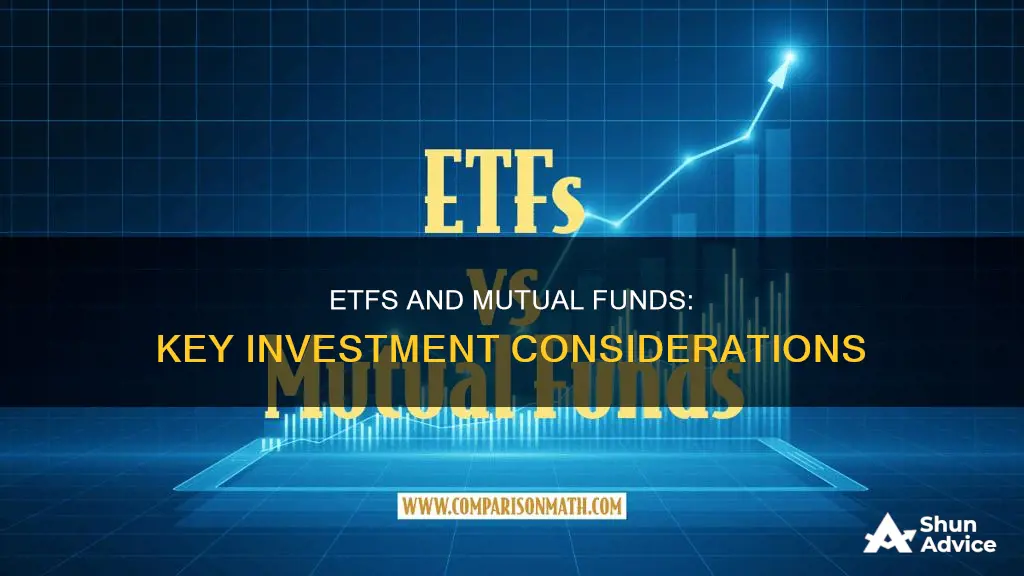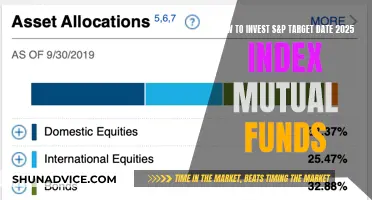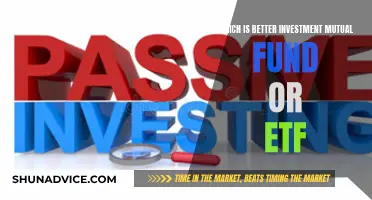
Exchange-traded funds (ETFs) and mutual funds are popular investment vehicles for investors looking to diversify their portfolios. While they share some similarities, there are key differences to consider when deciding which option is right for you. Here are some factors to keep in mind when investing in ETFs and mutual funds:
- Trading Flexibility: ETFs offer more flexibility in trading as they can be bought and sold on an exchange throughout the day, similar to stocks. In contrast, mutual funds can only be bought or sold once a day at the latest closing price.
- Investment Minimums: ETFs typically have lower investment minimums, allowing investors to purchase a single share. Mutual funds often require higher minimum investments, which can range from $500 to $5,000 or more.
- Management Style: ETFs are usually passively managed, tracking a market index or sector index. Mutual funds can be actively or passively managed, with fund managers making decisions about how to allocate assets.
- Tax Efficiency: ETFs are generally considered more tax-efficient due to their lower turnover and fewer transactions that produce capital gains. Mutual funds may trigger capital gains taxes when they sell securities within the fund.
- Costs and Fees: ETFs often have lower expense ratios compared to actively managed mutual funds. However, trading fees associated with buying and selling ETFs can add up, especially with frequent trading. Mutual funds may offer no-load options without commissions or sales charges.
- Suitability: The decision to invest in ETFs or mutual funds depends on your financial goals, risk tolerance, and investment style. ETFs may be suitable for those seeking lower costs, trading flexibility, and passive management. Mutual funds offer a wider range of investment strategies and are suitable for those seeking active management or automatic investment plans.
| Characteristics | Values |
|---|---|
| Investment types | ETFs and mutual funds are professionally managed collections of individual stocks or bonds. |
| Risk | Both are less risky than investing in individual stocks and bonds. |
| Investment options | Both offer a wide variety of investment options. |
| Control | ETFs offer more hands-on control over the price of your trade. |
| Investment minimums | ETFs have lower investment minimums. |
| Real-time pricing | ETFs provide real-time pricing. |
| Automatic investments and withdrawals | Mutual funds allow you to set up automatic investments and withdrawals. |
| Index funds | Most ETFs are index funds. |
| Commission | All ETFs and some mutual funds are commission-free. |
| Tax efficiency | ETFs are usually more tax-efficient. |
What You'll Learn
- Investment minimums: ETFs have lower minimums, often the cost of a single share. Mutual funds have higher minimums, often a flat dollar amount
- Management: ETFs are usually passively managed, tracking a market index. Mutual funds can be actively or passively managed
- Trading: ETFs are traded like stocks, throughout the day. Mutual funds are traded once a day, at the end of the trading day
- Fees: ETFs have lower fees and expense ratios. Mutual funds have higher fees, but also offer more services
- Tax efficiency: ETFs are generally more tax-efficient. Mutual funds can trigger capital gains tax liabilities

Investment minimums: ETFs have lower minimums, often the cost of a single share. Mutual funds have higher minimums, often a flat dollar amount
When it comes to investing in ETFs and mutual funds, one of the key considerations is the minimum investment required. This aspect can vary significantly between the two options.
ETFs (exchange-traded funds) typically have lower minimum investment requirements, often allowing investors to purchase a single share. The cost of a single ETF share can vary depending on the specific ETF, ranging from as little as $50 to a few hundred dollars. This flexibility makes ETFs more accessible to investors with limited funds or those who prefer to invest smaller amounts in multiple funds.
On the other hand, mutual funds usually have higher minimum investment requirements, often specified as a flat dollar amount. For example, the Vanguard 500 Index Investor Fund Admiral Shares require a $3,000 minimum investment. This higher minimum investment amount may be a factor for investors to consider when deciding between ETFs and mutual funds.
The difference in minimum investment requirements is primarily due to the way purchases are made for each type of fund. ETFs are bought and sold on an exchange, similar to stocks, so investors can purchase a single share at the market price. In contrast, mutual fund purchases are made directly with the fund provider, and the price is based on the fund's net asset value (NAV) calculated at the end of the trading day.
It's worth noting that while some mutual funds have minimum investment requirements, others may not have any minimum at all, allowing investors to purchase fractional shares or invest a fixed dollar amount. Therefore, investors should carefully review the specific requirements of the funds they are considering.
Dave Ramsey's Investment Strategy: Specific Fund Choices
You may want to see also

Management: ETFs are usually passively managed, tracking a market index. Mutual funds can be actively or passively managed
When it comes to management, there are some key differences between ETFs and mutual funds. ETFs (exchange-traded funds) are typically passively managed, meaning they track a market index or sector sub-index. In other words, they aim to match the performance of a particular index rather than trying to outperform it. This passive management style is one of the reasons why ETFs generally have lower fees and expense ratios compared to mutual funds. It's important to note that while most ETFs are passively managed, there is a growing range of actively managed ETFs available.
On the other hand, mutual funds are usually actively managed. This means that fund managers make decisions about how to allocate assets and buy and sell stocks or other securities within the fund to try to beat the market and maximise returns for investors. Actively managed funds tend to have higher fees and expense ratios due to their more complex operations and higher trading costs. However, some mutual funds are passively managed, particularly index funds, which aim to replicate the performance of a market index.
Both ETFs and mutual funds are overseen by professional portfolio managers who choose and monitor the stocks or bonds the funds invest in. These experts ensure that the funds stay aligned with their target indexes, even though the funds themselves may be passively managed.
Best S&P Index Funds: Top Picks for Your Portfolio
You may want to see also

Trading: ETFs are traded like stocks, throughout the day. Mutual funds are traded once a day, at the end of the trading day
Trading
ETFs and mutual funds differ in their trading behaviour. ETFs are traded on a stock exchange, like stocks, and their prices fluctuate throughout the day. This means that the price at which you buy an ETF will likely be different from the prices paid by other investors. ETFs can be bought and sold on the open market with other investors, and they are a good choice for active traders.
On the other hand, mutual funds are traded only once a day, at the end of the trading day. All investors who bought and sold that day will receive the same price, which is calculated after the market closes. This price is known as the net asset value (NAV). Mutual funds are, therefore, less complex and more suitable for those who want to keep things simple.
Bond Fund Investment: What Percentage is Smart to Invest?
You may want to see also

Fees: ETFs have lower fees and expense ratios. Mutual funds have higher fees, but also offer more services
When it comes to fees, there are some key differences between ETFs and mutual funds. ETFs are known for having lower fees and expense ratios compared to mutual funds. This is because ETFs are typically passively managed, meaning they track a market index or sector index, and do not require active decision-making from fund managers. As a result, the management fees associated with ETFs are generally lower.
On the other hand, mutual funds often involve active management, where fund managers actively buy and sell stocks or other securities within the fund to try to beat the market and maximise profits. This active management comes at a higher cost, as it requires more time, effort, and manpower for securities research and analysis. These higher costs are passed on to investors in the form of higher fees and expense ratios.
It is worth noting that the gap between ETF and mutual fund fees has narrowed in recent years, as mutual funds work to attract new investors. Additionally, some mutual funds may offer commission-free trading or have no minimum investment requirements, which can make them more cost-effective for certain investors.
When deciding between ETFs and mutual funds, it is important to consider not only the fees but also the level of service and management provided. Mutual funds may justify their higher fees by offering more hands-on management and additional services, such as automatic investment plans, check-writing options, and shareholder support services.
Ultimately, the decision between ETFs and mutual funds depends on an investor's financial goals, risk tolerance, and investment strategy. Both options offer benefits and drawbacks, and many investors choose to include both in their portfolios to gain the advantages of each.
Retirement Fund Investment: Choosing the Right Option
You may want to see also

Tax efficiency: ETFs are generally more tax-efficient. Mutual funds can trigger capital gains tax liabilities
When it comes to tax efficiency, ETFs generally have the upper hand over mutual funds.
ETFs are often passively managed, meaning they track a market index or sector sub-index. This passive management style tends to result in fewer capital gains than actively managed mutual funds, which try to beat the market by buying and selling securities to boost returns. Actively managed funds' higher operations and trading costs are reflected in their higher fees and expense ratios.
The creation and redemption process of ETFs also contributes to their tax efficiency. When an ETF shareholder redeems their investment, they receive an "in-kind redemption", which is a distribution of the underlying securities instead of cash. This structure limits the possibility of paying capital gains tax, as the ETF shareholder can choose when to sell the underlying securities and trigger the tax liability.
In contrast, mutual funds determine their price, or net asset value (NAV), at the end of each trading day. Mutual fund purchases and sales occur directly between investors and the fund, and the fund's price is based on the NAV. If an investor redeems their investment in a mutual fund, the fund may need to sell securities to raise the cash required to meet the redemption, potentially triggering a capital gains tax liability for all mutual fund shareholders.
Additionally, ETFs are priced continuously by the market, and their shares can be traded throughout the day on an exchange. This means that ETF investors can take advantage of intra-day pricing fluctuations and limit their tax liability by timing their sales strategically.
However, it is important to note that the tax efficiency of ETFs and mutual funds can vary depending on the specific fund and an investor's individual circumstances. Tax laws and regulations may also impact the tax implications of these investment choices.
Dimensional Fund Investing: What Products Are Offered?
You may want to see also
Frequently asked questions
ETFs (exchange-traded funds) are bought and sold on an exchange throughout the day, whereas mutual funds can only be bought or sold once a day at the latest closing price. ETFs are usually passively managed and track a market index or sector sub-index, while mutual funds are usually actively managed. ETFs are often cheaper to invest in, as mutual funds typically have minimum investment requirements. ETFs are also more tax-efficient than actively managed funds.
ETFs offer low-cost access to a variety of asset classes, industry sectors, and international markets. They are also more flexible, as they can be bought and sold like stocks, and there is no minimum investment requirement. Additionally, ETFs are professionally managed and provide instant diversification.
Mutual funds have been around for a long time and are well-established investment vehicles. They offer a wide range of investment strategies, including actively and passively managed options, allowing investors to choose a product that suits their risk tolerance levels and meets specific investment goals. Mutual funds also offer automatic investment plans, which ETFs do not, and provide more shareholder services.
ETFs carry unique risks, such as commissions and expenses, underlying fluctuations and risks, capital gains distributions, and reduced taxable income flexibility. Additionally, some ETFs may have low trading volume, resulting in wider bid-ask spreads and potentially impacting your ability to buy or sell shares at the desired price. It's also important to consider the fund's focus, underlying risks, and liquidity before investing.







